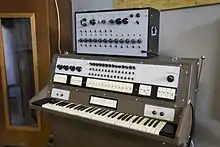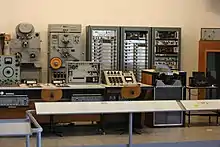.jpg.webp)
The Siemens Synthesizer (or "Siemens Studio für Elektronische Musik") was developed in Germany in 1959 by the German electronics manufacturer Siemens, originally to compose live electronic music for its own promotional films.[1]
From 1956 to 1967, it had a significant influence on the development of electronic music. Among others, Mauricio Kagel, Henri Pousseur, Herbert Brün and Ernst Krenek completed important electronic works there.[1]
History
In 1955, Siemens established an audio laboratory, the Siemens Studio für Elektronische Musik, in its Munich facilities to produce electronic music for its publicity films. Siemens engineers Helmut Klein and Alexander Schaaf were charged with assembling the components for the studio and providing a means for controlling the composition, synthesis, and recording of music. The organization of the studio was completed by 1959.[1][2] A second model was installed in 1964.[2]
The studio was closed in 1967 but its main control room and equipment have been preserved as part of a museum exhibit at the Deutsches Museum in Munich.[3]
From 1959 until its closure, Josef Anton Riedl was director of the studio.[4]

Technology
The Siemens Synthesizer was controlled by a set of four punch paper rolls controlling the timbre, envelope, pitch and volume. Equipment found in the studio included a bank of 20 oscillators, a white noise generator, a Hohnerola (a hybrid electronically amplified reed instrument marketed by Hohner) and an impulse generator. The synthesizer had a tonal range of seven octaves.[5]
The Siemens Synthesizer offered a method for controlling its tone-generating facilities, modification and modulation of the sounds in real time, and the manipulation of recorded material into finished works.[1]
Uses
Between 1960 and 1966, the studio opened its doors to many outside composers, including:
Gallery
 The mixer with a noise generator on the left and the frequency converter on the right. Behind it, a wall of 20 sine wave generators.
The mixer with a noise generator on the left and the frequency converter on the right. Behind it, a wall of 20 sine wave generators. A synchronous-motor moves the paper strips across the reader.
A synchronous-motor moves the paper strips across the reader. The studio equipments of the Siemens Studio für Elektronische Musik, referred as "Simens synthesizer".
The studio equipments of the Siemens Studio für Elektronische Musik, referred as "Simens synthesizer".
See also
Bibliography
- Stefan Schenk: Das Siemens-Studio für elektronische Musik. In: Münchner Veröffentlichungen zur Musikgeschichte, Band 72. Hans Schneider Verlag 2014, zugleich Dissertation an der Ludwig-Maximilians Universität München 2011, ISBN 978-3-86296-064-4. (Online)
- Wolf Loeckle: «Was gibt’s Neues?» Josel Anton Riedl, das Elektronische Siemens-Studio, die Natur. In: Neue Zeitschrift für Musik, Ausgabe 2014/2, S. 24–27.
- Helmut Klein: Klangsynthese und Klanganalyse im elektronischen Studio. In: Frequenz – Journal for RF, Band 16/1962 Nr. 3, S. 109–114
- Siemens Kulturprogramm (Hrsg.): Siemens-Studio für elektronische Musik. München 1994
- Siemens Kulturprogramm: Siemens-Studio für elektronische Musik. audiocom multimedia, 1998 (CD mit Kompositionen aus dem Studio)
References
- 1 2 3 4 5 6 7 8 9 Holmes, Thom (22 May 2012). "Early Synthesizers and Experimenters". Electronic and Experimental Music: Technology, Music, and Culture (4th ed.). Routledge (published 2012). pp. 190–192. ISBN 978-1-136-46895-7. (See also excerpt of pp. 157–160 from Holmes 2008)
- 1 2 3 4 Schmidt, Dörte. 2001. "Riedl, Josef Anton". The New Grove Dictionary of Music and Musicians, second edition, edited by Stanley Sadie and John Tyrrell. London: Macmillan Publishers.
- ↑ Museum, Deutsches. "Deutsches Museum: Projects". www.deutsches-museum.de. Retrieved 2021-03-03.
- ↑ The New Grove Dictionary of Music and Musicians (2nd edition (January 1, 2001) ed.). Oxford University Press. 2001. ISBN 978-0195170672.
- ↑ "The 'Siemens Synthesiser' H.Klein & W.Schaaf. Germany, 1959". 120 Years of Electronic Music. 2013-09-21. Retrieved 2021-03-02.
- 1 2 3 4 5 "history Siemens". 2010-11-25. Archived from the original on 2010-11-25. Retrieved 2021-03-03.